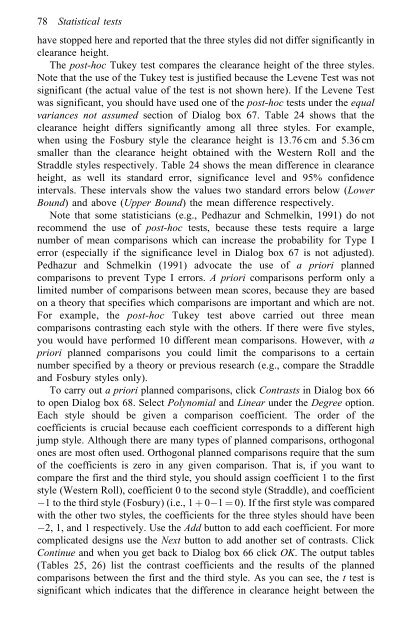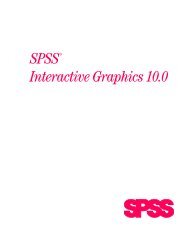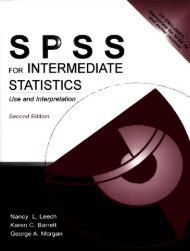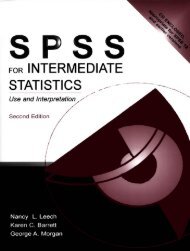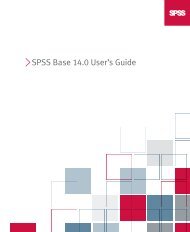A Step by Step Guide for SPSS and Exercise Studies
A Step by Step Guide for SPSS and Exercise Studies
A Step by Step Guide for SPSS and Exercise Studies
Create successful ePaper yourself
Turn your PDF publications into a flip-book with our unique Google optimized e-Paper software.
78 Statistical tests<br />
have stopped here <strong>and</strong> reported that the three styles did not differ significantly in<br />
clearance height.<br />
The post-hoc Tukey test compares the clearance height of the three styles.<br />
Note that the use of the Tukey test is justified because the Levene Test was not<br />
significant (the actual value of the test is not shown here). If the Levene Test<br />
was significant, you should have used one of the post-hoc tests under the equal<br />
variances not assumed section of Dialog box 67. Table 24 shows that the<br />
clearance height differs significantly among all three styles. For example,<br />
when using the Fosbury style the clearance height is 13.76 cm <strong>and</strong> 5.36 cm<br />
smaller than the clearance height obtained with the Western Roll <strong>and</strong> the<br />
Straddle styles respectively. Table 24 shows the mean difference in clearance<br />
height, as well its st<strong>and</strong>ard error, significance level <strong>and</strong> 95% confidence<br />
intervals. These intervals show the values two st<strong>and</strong>ard errors below (Lower<br />
Bound) <strong>and</strong> above (Upper Bound) the mean difference respectively.<br />
Note that some statisticians (e.g., Pedhazur <strong>and</strong> Schmelkin, 1991) do not<br />
recommend the use of post-hoc tests, because these tests require a large<br />
number of mean comparisons which can increase the probability <strong>for</strong> Type I<br />
error (especially if the significance level in Dialog box 67 is not adjusted).<br />
Pedhazur <strong>and</strong> Schmelkin (1991) advocate the use of a priori planned<br />
comparisons to prevent Type I errors. A priori comparisons per<strong>for</strong>m only a<br />
limited number of comparisons between mean scores, because they are based<br />
on a theory that specifies which comparisons are important <strong>and</strong> which are not.<br />
For example, the post-hoc Tukey test above carried out three mean<br />
comparisons contrasting each style with the others. If there were five styles,<br />
you would have per<strong>for</strong>med 10 different mean comparisons. However, with a<br />
priori planned comparisons you could limit the comparisons to a certain<br />
number specified <strong>by</strong> a theory or previous research (e.g., compare the Straddle<br />
<strong>and</strong> Fosbury styles only).<br />
To carry out a priori planned comparisons, click Contrasts in Dialog box 66<br />
to open Dialog box 68. Select Polynomial <strong>and</strong> Linear under the Degree option.<br />
Each style should be given a comparison coefficient. The order of the<br />
coefficients is crucial because each coefficient corresponds to a different high<br />
jump style. Although there are many types of planned comparisons, orthogonal<br />
ones are most often used. Orthogonal planned comparisons require that the sum<br />
of the coefficients is zero in any given comparison. That is, if you want to<br />
compare the first <strong>and</strong> the third style, you should assign coefficient 1 to the first<br />
style (Western Roll), coefficient 0 to the second style (Straddle), <strong>and</strong> coefficient<br />
1 to the third style (Fosbury) (i.e., 1 ‡ 0 1 ˆ 0). If the first style was compared<br />
with the other two styles, the coefficients <strong>for</strong> the three styles should have been<br />
2, 1, <strong>and</strong> 1 respectively. Use the Add button to add each coefficient. For more<br />
complicated designs use the Next button to add another set of contrasts. Click<br />
Continue <strong>and</strong> when you get back to Dialog box 66 click OK. The output tables<br />
(Tables 25, 26) list the contrast coefficients <strong>and</strong> the results of the planned<br />
comparisons between the first <strong>and</strong> the third style. As you can see, the t test is<br />
significant which indicates that the difference in clearance height between the


